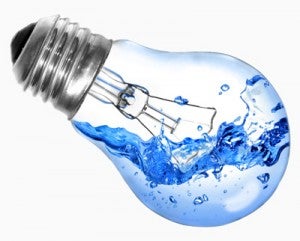The Nuts And Bolts — Or Rather Watts and Volts — Of The Energy-Water Lingo
A glossary of energy and water terms
 In recent posts I’ve discussed the need for energy and water planners to co-manage resources more comprehensively. But another significant barrier exists: language. Water and energy planners use different terminology and a lack of understanding for these distinctions hampers true coordination. Also, it prevents customers from understanding how to make sense of their own usage patterns and maximize energy and water efficiency.
In recent posts I’ve discussed the need for energy and water planners to co-manage resources more comprehensively. But another significant barrier exists: language. Water and energy planners use different terminology and a lack of understanding for these distinctions hampers true coordination. Also, it prevents customers from understanding how to make sense of their own usage patterns and maximize energy and water efficiency.
Electricity measurements
Getting into the nuts and bolts — or watts and volts — of the issue can get very dry very quickly, so let’s go over some basic units of measurement to set the stage.
Electricity is measured in watts, usually represented as kilowatts (kW), megawatts (MW), but often discussed as megawatt-hours (MWh). One MW is roughly equivalent to ten running cars engines. A MWh is the total amount of electricity produced by a power plant in one hour, roughly the amount of energy used by 330 homes in one hour. According to the U.S. Energy Information Administration (EIA), in May 2013, Texas generated 12,261 gigawatt-hours (GWh) of electricity from coal-fired power plants (1 GWh = 1,000 MWh) and only 4,116 GWh from renewable energy sources, such as wind and solar.
Water measurements
While electricity’s units of measurements are fairly streamlined, water is measured differently depending on volume. Specifically, acre-feet are used for large amounts (e.g. reservoirs, aqueducts and canals), while smaller amounts are measured in gallons. An acre-foot is the amount of water it would take to cover an acre of land with a depth of one foot, roughly 326,000 gallons. As an example, an Olympic-size swimming pool amounts to two acre-feet, and the average family of four uses roughly 400 gallons of water a day. Estimates of water use in the U.S. vary and are more difficult to estimate than electric use due to the inherent challenges of measurement and leaks, among other factors. The U.S. Geological Survey (USGS) estimates that in 2005, 410 billion gallons of water were withdrawn per day.
Withdrawal versus consumption
The term “withdrawn” brings us to another confusing set of terms: withdrawal versus consumption. As I mentioned in an earlier blog post, when talking about water for energy use, there is a distinction between these respective measurements, and this has a huge impact on both sectors.
Withdrawal is the amount of the water taken from the water source, whereas consumption is the portion of that water used and not returned to the original source for reuse. It should be noted that water returned to its original source exists in a different condition than when it was first withdrawn, which can contribute to stress on the water supply. The electric sector withdraws more water than any other sector in the U.S., amounting to more than 40%.

Efficiency versus conservation
Although the terms “energy conservation” and “energy efficiency” are often used interchangeably, they do in fact mean two different things.
Energy conservation refers to reducing energy waste. Examples include turning up your air-conditioning when you leave for the day or turning off the lights once you leave a room. Conservation is often associated with sacrifice, and many people still equate both conservation and efficiency with that sentiment.
Energy Efficiency refers to people using technology not only to reduce energy waste, but also to use less energy. For example, a new, efficient air conditioning unit will cool a house the same way an older unit can, but requires less energy to achieve the same effect. However, if a person runs the new unit all day at low temperatures while no one is home, they are wasting energy. .
Basically, efficiency involves technology and conservation involves behavior. But the biggest bang for the buck naturally comes with a combination of efficiency and conservation.
Water and energy use terminology may be technical, but understanding the similarities and differences will make all the difference when it comes to efficiently using our scarce resources and empowering people to engage in this very important conversation.











